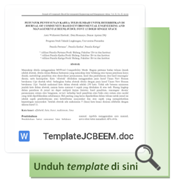Review of The Water Carrying Capacity and Water Flow at RDTR of The Spatial Planning of Tegalluar Residential Integrated Area in Bandung Regency
DOI:
https://doi.org/10.23969/jcbeem.v7i2.10211Keywords:
water flow, water carrying capacity, water cycle, water sensitive urban designAbstract
The development of Tegalluar area as a strategically planned integrated residential center, potentially serving as the new provincial government center for West Java, stands as a top priority for the Bandung Regency Government. To support this vision, the Regional Detailed Spatial Plan (RDTR) for Tegalluar Integrated Settlement Area and the Planning Area (BWP) of Bojongsoang have been formulated. Concurrently, the region has grappled with persistent water resource management challenges, marked by annual flooding during the rainy season and water shortages in the dry season. This research aims to comprehensively analyze the water flow cycle within the area and explore potential scenarios for water management in alignment with the RDTR. The research findings reveal that, in the development scenario, the water flow pattern remains largely unchanged, with limited efforts to harness rainfall or manage wastewater. Precipitation and surface water predominantly contribute to the water inflow in the research area. Furthermore, the provision of clean water heavily relies on external sources. Based on this water flow analysis, there exists an opportunity to implement water-sensitive urban design principles in the research area. This involves capturing rainwater through effective harvesting techniques and adopting wastewater reuse strategies, focusing on non-potable applications. Such measures can enhance water sustainability and mitigate the region's water-related challenges.
Downloads
References
Bahri, A. (2018). Teknologi bercocok tanam di lahan sempit di Kecamatan Tempe Kabupaten Wajo. 605–608.
Bartlett, T., Planning, D., & Unit, P. (2017). Urban metabolism in practice. 186.
Curmi, E., Fenner, R., Richards, K., Allwood, J. M., Bajželj, B., & Kopec, G. M. (2013). Visualising a Stochastic Model of Californian Water Resources Using Sankey Diagrams. Water Resources Management, 27(8), 3035–3050. https://doi.org/10.1007/s11269-013-0331-2
Development, L. I., Barrels, R., & Gardens, R. (n.d.). Rainfall as a Resource.
Jørgensen, C., Larsen, J., & Schrøder, O. (2013). Rethinking urban water for new value in cities.
Kaloeti, P. P., & Dewi, S. P. (2020). Analisis Faktor Konfirmatori Konsep Water Sensitive City pada Kawasan Permukiman Di Kecamatan Banyumanik. Jurnal Permukiman, 15(2), 84. https://doi.org/10.31815/jp.2020.15.84-94
Kenway, S., Gregory, A., & Mcmahon, J. (2011). Urban Water Mass Balance Analysis. 15(5). https://doi.org/10.1111/j.1530-9290.2011.00357.x
Lehrman, B. (2018). Visualizing water infrastructure with sankey maps: A case research of mapping the los angeles aqueduct, California. Journal of Maps, 14(1), 52–64. https://doi.org/10.1080/17445647.2018.1473815
Li, S., & Yu, W. (2010). Urban Water Balance Analysis by Holistic Approach. 1284–1289.
Loucks, D. P. E. van B. (2017). Water Resource Systems Planning and Management, An Introduction to Methods, Models, and Applications.
MAKROPOULOS, C., ROZOS, E., BRUASET, S., FRIJNS, J., & MARIËLLE VAN DER ZOUWEN. (2012). Best practices for Sustainable Urban Water Cycle Systems AN OVERVIEW OF AND ENABLING AND CONSTRAINING FACTORS FOR A TRANSITION TO SUSTAINABLE UWCSs.
Marsalek, J., Jiménez-Cisneros, B., Karamouz, M., Malmquist, P. A., Goldenfum, J., & Chocat, B. (2006). Urban water cycle processes and interactions: Urban water series. Urban Water Cycle Processes and Interactions: Urban Water Series - UNESCO-IHP, 78, 1–131.
Ou, X., Zhang, X., Xing, Y., Zhang, Q., & Zhang, X. (2014). China’s energy-water nexus in 2009 by Sankey diagram. Chemical Engineering Transactions, 42(2010), 31–36. https://doi.org/10.3303/CET1442006
Peraturan Bupati Bandung. (2021). Peraturan Bupati Nomor 24 Tahun 2021 Tentang RDTR Kawasan Terpadu Permukiman Tegalluar (Nomor 6, hal. 6). JDIH Kabupaten Bandung.
Minister of Environment Regulation. (2009). Peraturan Menteri LH No. 17 Tahun 2009 Tentang Pedoman penentuan daya dukung lingkungan hidup dalam penataan ruang wilayah. Pedoman Tata Cara Pengukuran Kriteria Baku Kerusakan Tanah Untuk Produksi Biomassa, 1–34.
Presiden Republik Indonesia. (2020). Undang Undang Republik Indonesia Nomor 11 Tahun 2020 Tentang Cipta Kerja. Peraturan.Bpk.Go.Id, 052692, 1–1187. https://peraturan.bpk.go.id/Home/Details/149750/uu-no-11-tahun-2020
Pronk, G. J., Stofberg, S. F., Van Dooren, T. C. G. W., Dingemans, M. M. L., Frijns, J., Koeman-Stein, N. E., Smeets, P. W. M. H., & Bartholomeus, R. P. (2021). Increasing Water System Robustness in the Netherlands: Potential of Cross-Sectoral Water Reuse. Water Resources Management, 35(11), 3721–3735. https://doi.org/10.1007/s11269-021-02912-5
Pusdiklat SDA. (2017). Modul hidrologi dan hidrolika sungai pelatihan pengendalian banjir 2017.
Renouf, M., Sochacka, B., Kenway, S., Lam, K. L., Serrao-, S., Morgan, E., & Choy, D. L. (2017). Urban metabolism for planning water sensitive city-regions Proof of concept for an urban water metabolism. 1–55.
Riehmann, P., Hanfler, M., & Froehlich, B. (2005). Interactive sankey diagrams. Proceedings - IEEE Symposium on Information Visualization, INFO VIS, May, 233–240. https://doi.org/10.1109/INFVIS.2005.1532152
Santoso, E. B., & Therik, L. V. (2016). Faktor Penentu Bertempat Tinggal Pada Kawasan Kumuh Di Kota Malang Berdasarkan Teori Doxiadis. Tataloka, 18(4), 261. https://doi.org/10.14710/tataloka.18.4.261-273
SNI 19-6728.1. (2002). Standar Nasional Indonesia No. 19-6728.1-2002 Penyusunan Neraca Source Daya - Bagian 1: Source Daya Air Spasial. Badan Standardisasi Nasional (BSN), ICS 13.060. 10.
Standar Nasional Indonesia. (2004). SNI 03-1733-2004 Tata Cara Perencanaan Lingkungan Perumahan di Perkotaan. Badan Standardisasi Nasional, 1–58.
Subramanyam, V., Paramshivan, D., Kumar, A., & Mondal, M. A. H. (2015). Using Sankey diagrams to map energy flow from primary fuel to end use. Energy Conversion and Management, 91, 342–352. https://doi.org/10.1016/j.enconman.2014.12.024
Wong, T. H. F. (2006). Water sensitive urban design - the journey thus far. Australasian Journal of Water Resources, 10(3), 213–222. https://doi.org/10.1080/13241583.2006.11465296














